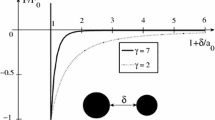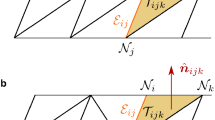Abstract
Soft particle materials such as some pharmaceutical and food products are composed of particles that can undergo large deformations under low confining pressures without rupture. The rheological and textural properties of these materials are thus governed by both particle rearrangements and particle shape changes. For the simulation of soft particle materials, we present a numerical technique based on the material point method, allowing for large elasto-plastic particle deformations. Coupling the latter with the contact dynamics method makes it possible to deal with contact interactions between particles. We investigate the compaction of assemblies of elastic and plastic particles. For plastic deformations, it is observed that the applied stress needed to achieve high packing fraction is lower when plastic hardening is small. Moreover, predictive models, relating stress and packing fraction, are proposed for the compaction of elastic and plastic particles. These models fit well our simulation results. Furthermore, it is found that the evolution of the coordination number follows a power law as a function of the packing fraction beyond jamming point of hard particle packings.





Similar content being viewed by others
References
Sinka C (2007) Modelling powder compaction. KONA Powder Particle J 25:4
Pitt KG, Webber RJ, Hill KA, Dey D, Gamlen MJ (2015) Compression prediction accuracy from small scale compaction studies to production presses. Powder Technol 270:490
Wu CY, Ruddy O, Bentham A, Hancock B, Best S, Elliott J (2005) Modelling the mechanical behaviour of pharmaceutical powders during compaction. Powder Technol 152:107
Krok A, Peciar M, Fekete R (2014) Numerical investigation into the influence of the punch shape on the mechanical behavior of pharmaceutical powders during compaction. Particuology 16:116
Moghaddam M, Darvizeh R, Davey K, Darvizeh A (2018) Scaling of the powder compaction process. Int J Solids Struct 144:192
Wu CY (2008) DEM simulations of die filling during pharmaceutical tabletting. Particuology 6:412
Barnabe M, Blanc N, Chabin T, Delenne JY, Duri A, Frank X, Hugouvieux V, Lutton E, Mabille F, Nezamabadi S et al (2017) Multiscale modeling for bioresources and bioproducts. Innov Food Scie Emerg Technol 46: 41–53
Choi J, Gethin D (2009) A discrete finite element modelling and measurements for powder compaction. Model Simul Mater Sci Eng 17:035005
Nezamabadi S, Nguyen T, Delenne JY, Radjai F (2017) Modeling soft granular materials. Granul Matter 19:8
Nezamabadi S, Radjai F, Averseng J, Delenne JY (2015) Implicit frictional-contact model for soft particle systems. J Mech Phys Solids 83:72
Nezamabadi S, Frank X, Delenne JY, Averseng J, Radjai F (2019) Parallel implicit contact algorithm for soft particle systems. Comput Phys Commun 237:17
ANSYS (2009) ANSYS theory reference for the mechanical APDL and mechanical applications, 12th edn. In: ANSYS theory reference for the mechanical APDL and mechanical applications. ANSYS Inc., Canonsburg, PA
Andersen S, Andersen L (2010) Analysis of spatial interpolation in the material-point method. Comput Struct 88:506
Kováčik J (1999) Correlation between Young’s modulus and porosity in porous materials. J Mater Sci Lett 8:1007
Kováčik J (2001) Correlation between shear modulus and porosity in porous materials. J Mater Sci Lett 20:1953
Samimi A, Hassanpour A, Ghadiri M (2005) Single and bulk compressions of soft granules: experimental study and DEM evaluation. Chem Eng Sci 60:3993
Stasiak M, Tomas J, Molenda M, Rusinek R, Mueller P (2010) Uniaxial compaction behaviour and elasticity of cohesive powders. Powder Technol 203:482
Zhou M, Huang S, Hu J, Lei Y, Zou F, Yan S, Yang M (2017) Experiment and finite element analysis of compaction densification mechanism of Ag–Cu–Sn–In mixed metal powder. Powder Technol 313:68
O’Hern C, Silbert L, Liu A, Nagel S (2003) Jamming at zero temperature and zero applied stress: the epitome of disorder. Phys Rev E 68:011306
van Hecke M (2010) Jamming of soft particles: geometry, mechanics, scaling and isostaticity. J Phys Condens Matter 22:033101
Zhang J, Majmudar TS, Sperl M, Behringer R (2010) Jamming for a 2D granular material. Soft Matter 6:2982
Acknowledgements
This work (Project ID 1502-607) was publicly funded through ANR (the French National Research Agency) under the “Investissements d’avenir” programme with the reference ANR-10-LABX- 001-01 Labex Agro and coordinated by Agropolis Fondation, France, under the frame of I-SITE MUSE (ANR-16-IDEX-0006). We are also grateful to the Genotoul bioinformatics platform Toulouse Midi- Pyrenees (Bioinfo Genotoul) for providing computing resources.
Author information
Authors and Affiliations
Corresponding author
Ethics declarations
Conflict of interest
The authors declare that they have no conflict of interest.
Additional information
Publisher's Note
Springer Nature remains neutral with regard to jurisdictional claims in published maps and institutional affiliations.
Appendix 1: Relation between the applied stress, \(\sigma \), and the packing fraction, \(\varPhi \), for an elastic packing under uniaxial compression
Appendix 1: Relation between the applied stress, \(\sigma \), and the packing fraction, \(\varPhi \), for an elastic packing under uniaxial compression
We assume that the packing of particles behaves almost as a continuum porous medium beyond the jamming point under uniaxial compression. Hence, in this range the applied stress \(\sigma \) may be related to the cumulative vertical strain \(\varepsilon \) through an effective P-wave modulus \(M^{\mathrm{eff}}\):
One may further assume that the particle bulk modulus K relates the volume increment \(\text {d} V_S\) of particles to the effective stress increment \(\text {d} \sigma _S\) in particles:
\(\sigma \) can be related to \(\sigma _S\) as follows:
where \(c_1\) is a material constant to be determined. Given that \(\text {d} \varepsilon =\text {d} V_S/V_S-\text {d} \varPhi / \varPhi \) and using Eqs. (18), (19) and (20), the following differential equation to solve is obtained:
By knowing that \(M^{\mathrm{eff}}\) and Z are related to \(\varPhi \) (see Eqs. (7) and (17)), the integration of the differential equation (21) yields:
where \(c_2\) is the integral constant.
Rights and permissions
About this article
Cite this article
Nezamabadi, S., Ghadiri, M., Delenne, JY. et al. Modelling the compaction of plastic particle packings. Comp. Part. Mech. 9, 45–52 (2022). https://doi.org/10.1007/s40571-021-00391-4
Received:
Revised:
Accepted:
Published:
Issue Date:
DOI: https://doi.org/10.1007/s40571-021-00391-4




